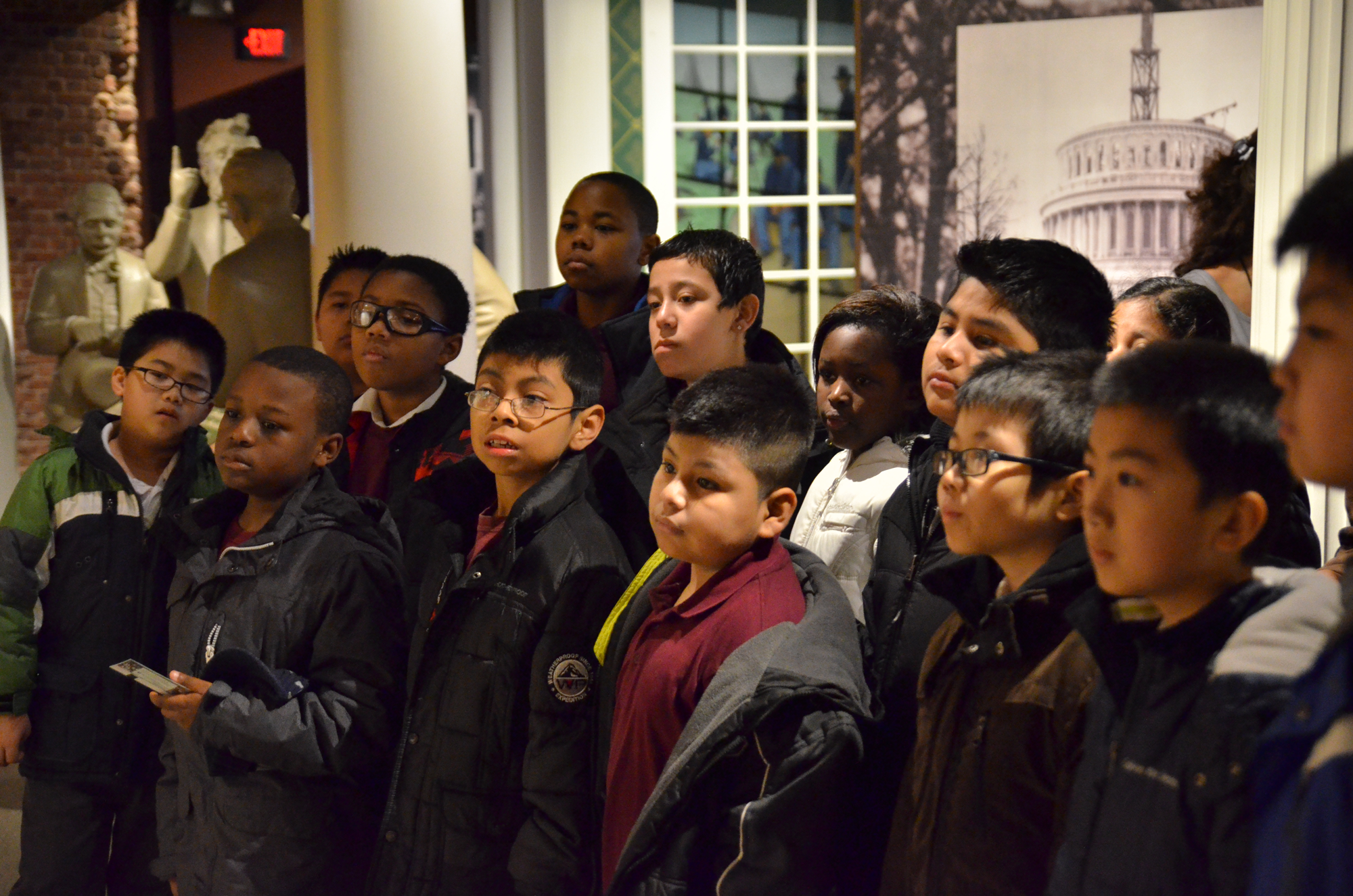
How Relevant is too Relevant? Connecting Past & Present at the Ford’s Museum: Prototyping Sprint 2- Round 1 (Part 1)
Student groups visiting Ford’s Theatre on the morning of Monday, March 12, 2018, saw some test features in our Museum: Flip doors with questions about Lincoln’s decisions while in office. This was the first round of the second sprint of experiments in our prototyping project: Design Research at Ford’s Theatre (D.R.A.F.T.). Our team comprised several Ford’s staff members and Kate Haley Goldman, facilitator and evaluator.

Getting to the Ideas
Prior to this second prototyping sprint, we worked to refine our ideas of what was most critical to prototype in the museum or elsewhere and why. Ford’s Theatre, like many historic sites, is evolving. Our staff is reflecting on the core messages of the site and how those messages connect or fail to connect with different visitors.
In our discussions, the D.R.A.F.T. team articulated a number of priorities to address in coming sprints:
- Better prepare/orient the visitors for each stage of the visit
- Better use the space, including lines, stairwells and other places
- Increase a visitor’s sense of relevance of and connection to the content
- Increase the sense of the emotional context of the events
- Adapt the content for different visitorship levels and amount of crowding
- Unify the campus (the Ford’s site consists of multiple buildings)
- Encourage visitors to see more of the site
While we had a sense of the issues we were attempting to address, we were unable to discern from conversation alone what was most important to the team. To address this we developed a very quick team survey, asking the team to rank their priorities out of the above list.
We asked them to rank the priorities twice. The first rating focused on problems to address with short-term, low-cost solutions. Secondly, we asked the team to think more long-term and rank which issues they would tackle when thinking about the development of the site in the coming years.
For both short-term and long-term, the results were quite clear. The D.R.A.F.T. team strongly wishes to concentrate on increasing a visitor’s sense of relevance of the content and increasing the sense of the emotional context of the events.
With that as a mandate, we moved forward into this round with an issue and context already in mind.
How might we increase a visitor’s sense of relevance of the content with short-term, low-cost solutions?

After agreeing that relevance was our central focus for this round, the D.R.A.F.T. team met on a Monday morning. We were ready to come up with ideas on how to connect past and present.
One key element of our discussion was to focus on a definition of relevance. We decided that content that is relevant to visitors better connects to their lives and the world around them.
Since we had agreed on the premise to tackle with this sprint, everyone reviewed prior ideas, delved into the current content and brainstormed their ideas individually. We then presented thoughts to the wider group.
In the end, the group chose to go with a simulation of the 1864 election, in which students would answer questions about the issues presented and then see for whom they likely would have voted. Further refining yielded a plan not specifically focused on the 1864 election itself but instead the wider issues of the Civil War and Lincoln’s presidency.
When the group came back together for our work session, the plan quickly evolved. The group came up with a series of statements about controversial aspects of the Lincoln presidency.

Ideation
One of the areas with which we most struggled was language. How specific did we want to make our language about the Lincoln presidency, versus phrased in broader terms? In the end, after voting, we chose a set of five questions, each prefaced the same way:
- Would you support a president who allowed anyone to come to the White House to talk to them face-to-face?
- Would you support a president who allowed non-citizens to vote if they served in the U.S. military?
- Would you support a president who allowed the police to put a person in jail who might commit a crime but hasn’t yet?
- Would you support a president who set aside time for themselves to relax and escape during a time of armed conflict?
- Would you support a president who passed executive orders without Congress’s consent in support of military goals?
We knew that Lincoln had done each of these things and we would explain them in the museum. But in our efforts to make connections between the past and present, we were surprised to encounter some resistance from visitors as we introduced the project.
The Experiment
We created two components for this experiment:
- A ballot to be handed to students as they came into the site, with these questions and a small set of instructions.
- In five spots throughout the Museum exhibits, we put down floor stickers shaped like blue X’s (which we had on hand, thanks to a shipping error–a big part of prototyping is using what you have). Above those X’s, we hung flip doors–printed on letter-size cardstock–with that same question, and underneath, an explanation of how Lincoln had done what the question asked.

We tested on Monday, March 12, 2018–the first day of our peak visitor season.
Ford’s Visitor Services Manager Colleen Prior took the ballots and spoke with leaders of visiting groups, who then handed the ballots out. The groups then entered the museum, where our staff/D.R.A.F.T. observers were stationed near each question, to watch how students interacted (or didn’t) with the flip doors and, if possible, to listen to their responses.

After students went through the museum, our D.R.A.F.T. questioners attempted to interview anyone who had a ballot. The questions included:
- When you were looking at the voting information, did the information about Lincoln surprise you? Which pieces?
- Before you got here, did you think Lincoln was controversial in his day?
- What do you think now?
- Are the items you voted on about Lincoln relevant to today? Why or why not?
We then tested for the next three hours, during which nearly 500 students were scheduled to walk through the site. We made some adjustments during the experiment:
- One sign was in an area with relevant content but almost no light, so we moved it to a brighter spot.
- We found that questioning students in the theatre wasn’t working (more on that below), so we moved the questioning into the museum.
This project is made possible in part by the Institute of Museum and Library Services, grant number MA-10-16-0180-16.
To see the take-aways from our experiment, please click through to the second blog post on this sprint Click Here
David McKenzie is Ford’s Theatre Associate Director for Interpretive Resources. He also is currently a History Ph.D. candidate at George Mason University, studying 19th-century U.S. and Latin American history, as well as digital history. Before coming to Ford’s in 2013, he worked at the Jewish Historical Society of Greater Washington, The Design Minds, Inc. and at the Alamo.Chat with him on Twitter @dpmckenzie.
Kate Haley Goldman is an evaluator and strategist, currently working with Ford’s Theatre Society, Lower East Side Tenement Museum, AAAS and others. She works on projects with difficult cultural history, citizen science, digital storytelling, data-based decision-making, institutional capacity building and long-term visitor outcomes.Chat with her on Twitter @KateHG4.

